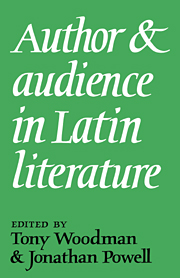Book contents
- Frontmatter
- Contents
- List of contributors
- Prologue
- 1 THE ORATOR AND THE READER: Manipulation and response in Cicero's Fifth Verrine
- 2 STRATAGEMS OF VANITY: Cicero, Ad familiares 5.12 and Pliny's letters
- 3 ‘SHALL I COMPARE THEE…?’: Catullus 68B and the limits of analogy
- 4 ATOMS AND ELEPHANTS: Lucretius 2.522–40
- 5 IN MEMORIAM GALLI: Propertius 1.21
- 6 THE POWER OF IMPLICATION: Horace's invitation to Maecenas (Odes 1.20)
- 7 THE VOICE OF VIRGIL: The pageant of Rome in Aeneid 6
- 8 FROM ORPHEUS TO ASS'S EARS: Ovid, Metamorphoses 10.1–11.193
- 9 POET AND AUDIENCE IN SENECAN TRAGEDY: Phaedra 358–430
- 10 PERSIUS' FIRST SATIRE: A re-examination
- 11 NERO'S ALIEN CAPITAL: Tacitus as paradoxographer (Annals 15.36–7)
- 12 AMOR CLERICALIS
- 13 EPILOGUE
- Notes
- Abbreviations and bibliography
- Indexes
9 - POET AND AUDIENCE IN SENECAN TRAGEDY: Phaedra 358–430
Published online by Cambridge University Press: 13 March 2010
- Frontmatter
- Contents
- List of contributors
- Prologue
- 1 THE ORATOR AND THE READER: Manipulation and response in Cicero's Fifth Verrine
- 2 STRATAGEMS OF VANITY: Cicero, Ad familiares 5.12 and Pliny's letters
- 3 ‘SHALL I COMPARE THEE…?’: Catullus 68B and the limits of analogy
- 4 ATOMS AND ELEPHANTS: Lucretius 2.522–40
- 5 IN MEMORIAM GALLI: Propertius 1.21
- 6 THE POWER OF IMPLICATION: Horace's invitation to Maecenas (Odes 1.20)
- 7 THE VOICE OF VIRGIL: The pageant of Rome in Aeneid 6
- 8 FROM ORPHEUS TO ASS'S EARS: Ovid, Metamorphoses 10.1–11.193
- 9 POET AND AUDIENCE IN SENECAN TRAGEDY: Phaedra 358–430
- 10 PERSIUS' FIRST SATIRE: A re-examination
- 11 NERO'S ALIEN CAPITAL: Tacitus as paradoxographer (Annals 15.36–7)
- 12 AMOR CLERICALIS
- 13 EPILOGUE
- Notes
- Abbreviations and bibliography
- Indexes
Summary
Plautus (like his Greek predecessors) occasionally breaks the dramatic illusion and addresses the spectators directly in a gesture of comic inappropriateness. That is theatrical farce, and only has its place in a theatre – Plautus clearly did not envision his plays as being read. It is quite different with Seneca, and I want to use this auspicious occasion to examine his relationship with an audience.
In much of the poetry that was composed from the time of Catullus to the death of Horace, the reader/audience is an eavesdropper; he or she overhears a private conversation in which the poet speaks with another person or with himself. Such poetry is often overtly presented as confessional, so that what is revealed purports to be in some sense private to the poet.
This is a form of composition peculiarly suited to the type of autobiographical love-poetry that Catullus invented. That poetic stance was adopted also by Propertius in Books 1–3, by Tibullus, and by Horace in Odes 1–3 (and in a few personal odes in Book 4). There are, of course, exceptions. Propertius 3.18, the funeral elegy for Marcellus, is, I suspect, to be envisioned as being actually delivered viva voce by the poet at the funeral ceremony; and that is why Marcellus‘ name does not occur in the text (and is only imported into it by emendation with great awkwardness).
- Type
- Chapter
- Information
- Author and Audience in Latin Literature , pp. 138 - 149Publisher: Cambridge University PressPrint publication year: 1992



